To tell the truth, I’ve stolen the expression DELUXE from someone else. I stumbled over the idea that the MFB Dominion 1 synthesizer should actually be called “Dominion Deluxe” while reading a short description on the Schneiders Laden website. And Andreas Schneider kindly gave me permission to spread this idea among our faithful readers. So the new MFB offspring will now be called DELUXE – a noble attribute it well deserves.
How did MFB come to build such an impressive synth? Let’s turn the clock back a few years. 35 years, to be exact. In 1979 Manfred Fricke began producing synthesizers, sequencers and drum computers, which is to say he began building electronic music instruments. His small company in Berlin has since brought out many interesting products, notwidthstanding the trials and tribulations of time. Dominion 1 appeared on the market in the summer of 2014, after an imposing 3 years of development by Manfred Fricke and Uwe George Giegler (aka yapacc).
Our earlier report on the MFB Dominion X / X SED – the OSCar effect included an in-depth discussion of the Dominion desktop version. Many of the nice little details discussed there are still relevant, of course, but the keyboard version has some new little niceties as well.
Our songs of praise for the Dominion 1 should be underscored, considering the scanty range of new analog synthesizers on the market today. Yamaha and Roland don’t feel any necessity there and have no analog synths in their program. Korg does go along with the fun, but their analog groove instruments (Volca Series) are rather small, aside from those diverse MS-20 clones. So, let’s cast a glance not at the BIGGIES, but at the LITTLE ones.
Moog is still clinging to the successor-of-the-successor-of-the-successor-of-the-Minimoog concept. Voyager, Little Phatty, Sub XY – … for those of you who still don’t have a synth with a cascade filter: you can choose amongst the many! Tom Oberheim’s SEM modules are well know and reliable. And Dave Smith has remained loyal to his Prophet-line – Prophet-12, Pro-2: old classics in new cloths – at least according to their name (the technical part, of course, is brandnew and up to date). Arturia’s hardware synth-debut with MiniBrute and MicroBrute is a promising start on the analog side of things.
So the world market is more or less flooded with new analog synths based on the names of old classics (but without the instrument’s original sound quality), with a few exceptions here and there. However, innovation is something else, more a domain of the modular/Eurorack field (Endorphin.es, Make Noise, Cwejman, Doepfer, Verbos …) and of the stand-alone synth-area (MacBeth Elements, Dreadbox Murmux, Vermona PERfourMER MKII, Elektron Analog Four …). Be that as it be …
MFB’s Dominion 1 is in many ways just the ticket. This analog synth (3-octave- keyboard, MIDI, CV-patch field) with its vast sound architecture and its many controllers is the product of an unusual concept. Dominion 1 is one of those rare instruments that completely covers studio analog sound-and-performance requirements. Add a polyphonic synth, a drum computer and a notebook (for recording) and you’re all set! Nothing else is needed – the Dominion 1 fullfills your every wish. That’s its job.
[Ok, ok … the new Arturia MatrixBrute surpasses the Dominion 1 in many ways. But while Arturia synthesizers (generally) sound a little clinical and straight, the Dominion 1 offers an amazingly warm – deeply analog – sound.]
The hardware
The Dominion 1 is suprisingly heavy. A well-built metal case, solid wooden panels – no complaints there. It’s great that it has an integrated power supply (not to be taken for granted these days). The big knobs are comfortable to use (don’t worry – we’ll get to some criticism later). Those white (or black) dots watching you from the buttons are lovely remeniscences of the vintage RSF Kobol synth. The various color combinations allow for a quick overall survey of the sound architecture.
Whereby dreams are allowed. To be honest, the “ideal” Dominion 1 would be somewhat larger. The closely positioned knobs have resulted in miniscule printing. A little hard to read, a little hard to adjust. Font size 8, we would estimate. And that is not very large. Affording good lighting and exacting glances, if you want to keep everything under control.
Which is to say a larger Dominion 1 would allow not only for more room between the knobs, but also for larger font size (8.5 – smile). Not to mention that there would be room for a 3,5- or 4-octave keyboard, along with an extra pitch bender / mod wheel unit in addition to the existing ribbon controllers. That would be luxury pure.
Be that as it be, the Dominion 1 knobs are very good. You can get a good grip on them, they are large and stable. We can’t say the same for the faders. They are one of the very few weak points of the instrument. They sort of sprawl and wiggle. Which is just a little dent in the excellent impression Dominion 1 has made on us. Something we can live with. And something you can certainly make excellent music with.
And then there are those little black switches – for selecting sounds (a grand total of 128 can be saved!), and for various system functions. They do a good job. The two ribbon controllers are of high quality and the cv-panel jacks are well-attached to the chassis. So, aside from the faders, the overall hardware quality is on a high level.
A small but very remarkable new aspect deserves to be mentioned here. The printing on the back appears doubled: normal and upside down. Which is something you also find by the diverse Manikin- and Jomox-instruments (shall we call this a Berlin nicety?). Very useful when changing MIDI connections, for example. Slightly upending the instrument gives you a full view of the rear side connections.
The concept
Before taking the individual parts of the Dominion 1 into consideration, let’s take a quick look at the overall concept of the instrument.
It didn’t take long for the Dominion 1 to gain its reputation as the epitome of monophonic analog synthesizers with keyboard, MIDI and CV/Gate. That is to say the epitome of monophonic analog synthesizers with keyboard, MIDI and CV/Gate along with all its inherent creative possibilities. To say it in a nutshell, the perfect (monophonic) analog synth many musicians have been looking for.
As far as hardware design is concerned, we would certainly welcome an expanded version of the Dominion 1 (more distinct lettering, better faders and an extended keyboard). But wishful thinking aside, what are we really looking for? There is nothing spectacular missing on the Dominion 1. It has everything. And it can do everything. All modulations, all thinkable connection possibilities, all kinds of filters, lots of controllers … its concept is nearly perfect.
Taking it from there, let’s look at the Dominion 1 in detail …
3 versatile VCOs
The 3 VCOs are – more ore less – identical:
- VCO1: triangle, sawtooth, pulse, analog ring modulator
- VCO2: triangle, sawtooth, pulse, digital ring modulator
- VCO3: triangle, sawtooth, pulse, digital ring modulator
Oscillator tuning possibilities are superb. The six-stage octave selector ranges from 32’ to 1’. In addition, there’s a regular (fine) tune knob. VCO1 tuning sets the general tuning for all three oscillators (and thus for the whole instrument), the range is approx. ±6 semi tones. Tune control for VCO2 and VCO3 range approx. ±13 semi tones, allowing detuning by a little more than an extra full octave. So, all in all VCO2 and VCO3 have a tonal range of more than 7 octaves …
Various aspects of each VCO can be modulated:
- Level – pre-mixer level modulation by LFO1
- Pitch1 – pitch modulation by LFO1 (up to ± 2 octaves)
- Pitch2 – pitch modulation by LFO2 (up to ± 2 octaves)
- ADSR1– pitch modulation by envelope ADSR1
- PWM – modulation of waveform symmetry by LFO1
- PW – manual modulation of waveform symmetry by Modulation control
LEVEL modulation is a very handy feature, allowing to fade-in and fade-out single oscillators. PITCH modulation is a very powerful feature, since the modulation sources are wide-range LFOs (LFO1 and LFO2, going – in key-track mode – up to 1,2 kHz). PWM and PW are very unusual features, since they can affect the symmetry of all VCO waveforms (… this is not only pulse-width-modulation, but also triangle-width- and sawtooth-width-modulation, to be exact).
And then there is a separate oscillator FM section:
- VCO1 – is modulated by VCO3
- VCO2 – is modulated by VCO3
- VCO1+2 – are both modulated by VCO3
The amount of frequency modulation can be set manually or dynamically using one of the following sources:
- LFO1
- LFO2
- ADSR1
- ADSR2
- AD
Ah yes … instead of VCO3 you may use an external signal (fed into the FM In jack) for oscillator FM. And last but not least there is the patchbay, containing CV-INs and CV-OUTs for all VCOs. Not bad, hm …?
Unique VCF with 12 modes
The Dominion 1 multimode filter is quite unique in synth history. (Ok, there’s the Oberheim Xpander / Matrix-12 multimode filter with 15 different modes … but other than that …). All modes are based upon the SED circuit (Single-Ended & Discrete).
Use “Filter Select” to choose between these FILTER MODES:
- LP1 – 24 dB LowPass
- LP2 – 18 dB LowPass
- LP3 – 12 dB LowPass
- LP4 – 6 dB LowPass
- BP1 – BandPass with 18 dB LowPass and 6 dB HighPass
- BP2 – BandPass with 12 dB LowPass and 12 dB HighPass
- BP3 – BandPass with 6 dB LowPass and 6 dB HighPass
- BP4 – BandPass with 6 dB LowPass and 12 dB HighPass
- NO1 – BandPass with 6 dB LowPass and 6 dB HighPass
- NO2 – Notch combining 6 dB LowPass and 6 dB HighPass and additional 6 dB LowPass
- HP1 – 6 dB HighPass
- HP2 – 12 dB HighPass
One might suspect that this is a little exaggerated. “Ok, where is the difference between LP2 and LP4?” True – the difference between this and that filter sometimes seems to be not “that” big. BUT … think it over and you’ll figure out that there’s a correlation between filter resonance, filter frequency and the effectiveness of certain filter types. BandPass and HighPass show their true faces at HIGH resonance settings and LOW filter frequency. Fiddle around and you’re in for the one or other eye-opening experience …
In sum, the tonal potential of the Dominion 1 filter is enormous. The strong / dominant LowPass filters and the creamy Notch filters produce real delicacies. But what can you say? BandPass and HighPass are sometimes even more powerful (remember the filter-resonance-thing?), with a wide range of beautiful tone colors. Just listen to the 40 minutes of audio files attached.
This filter is one of the finest in synth history. As we say: it is DELUXE!
You might have discovered in the above graphic that filter resonance modulation is possible, too. Quite a rare feature, really. Hm … ok, ok … regarding music performance, resonance modulation is not always that efficient. (No wonder that it is just not that common.) BUT … let’s go back once more to the correlation between filter resonance, filter frequency and the effectiveness of certain filter types (especially BandPass and HighPass). The sheer power of those filters comes into its own at higher resonance settings, so – we’re closing the circle – resonance modulation IS quite a handsome feature.
But there’s more! The filter may be modulated from innumerable sides. Have a close look at the following chart …
Dominion 1 offers the following areas for filter modulation (all available simultaneously, of course):
- VCF MOD (to be found directly in the filter section, with various modulation sources)
- Ribbon 1 and Ribbon 2
- Aftertouch and Velocity
- ADSR1 (and also ADSR2 and AR via patchbay)
- Filter CV-IN
- Sequencer
- MIDI
Still missing something? I’d say “no”!
Envelopes and LFOs
Well, Euphoria, just cool down a little bit. The envelopes are good, but not fantastic. They are software-based (now we have the villain!). Software is not necessarily a bad thing per se, but the chip inside Dominion 1 is not that powerful. To be clear: the envelopes are a bit sluggish. The ZAPPPP !, is missing. You can still make excellent music with these envelopes (listen to the soundfiles), but purists might miss a certain sharpness and aggressivness in the sound.
The LFOs bring color back into your life. 3 LFOs is a real luxury! Granted, they too are software-based, but somehow this has no negative influence on the expressive potential of the Dominion 1. Each of the two main-LFOs offers six waveforms, including sample & hold.
LFO frequency ranges from 1 cycle per 40 seconds (beautiful!) up to 1.2 kHz. That – again – is DELUXE. High audio-ranges can be achieved by activating key mode. The higher you play, the faster the LFO. I like the versatility of this concept: ultra-slow on the one side (perfect for mystic filter sweeps), going up to a hot 1 kHz on the other side (perfect for vocal filter sounds or other effects) … the best of both worlds!
The two main LFOs have their own CV-outputs, just in case you wanna use them to control other instruments or modules. Keen observers may have noticed a small (and quite funny) typographical error here: LF01 and LF02 should be written LFO 1 and LFO 2.
LFO2 In (sorry, LF02 In) is a special little nicety, allowing for modulation of the LFO2 speed. All in all the Dominion 1 has 3 LFOs. One is used in the modulation ribbon section (for all kinds of vibrato- and wah-wah-effects), the other two are workaholics (massive amounts of waveforms, frequency ranges from 40 seconds up to 1,2 kHz) … and one of the workaholics is even voltage controllable!
Ribbon controllers
Let’s be clear about this: the ribbon controllers are excellent. These tools are clearly superior to any ordinary pitch bend-/mod wheel-concept in regard to flexibility and musical expressiveness. Nevertheless, there may be differing opinions on this …
On the one side you can produce non-linear modulations with a ribbon. “Play” the filter frequency with your fingertips, create micro-tonal melodies bouncing back and forth on the ribbon. Lots of possibilities on the creative side …
In contrast, ordinary pitchbend playing – to be heard in every mainstream synth-pop hit – is more difficult. A real pitch bender is a lever, a physical piece of plastic (or metal) to move, giving you more grip and performance-security than the mere slip of your fingers on the ribbon surface.
The following modulation destinations can be selected by either Pitch Ribbon and Modulation Ribbon (= LFO3):
- VCO – pitch of all three oscillators
- VCO2 – pitch of VCO2 (e.g. for sync)
- VCO3 – pitch of VCO3 (e.g. for XOR)
- VCO2+3 – pitch of both VCO2 and VCO3
- VCF – filter cutoff frequency
- VCA – output volume
Patch panel
It’s the analog synthesist’s dream: a versatile instrument with a huge (and well-arranged) patch panel, allowing the unit to be used with analog control voltages (CV) and gate signals. Dominion 1 has 26 CV in/outputs. Thus, the instrument is compatible with all common Eurorack modular synthesizer systems.
Sequencer and arpeggiator
The arpeggiator of the Dominion 1 grooves beautifully (listen to the sound file “Arpeggiator”). Nothing else to say here – most of you know what to do anyway with a powerful arpeggiator.
The sequencer allows you to record 128 steps, which is sufficient for basslines and short patterns.
“To create an individual sequence, first press the Record button once. The display will now show the current resolution (initial setting Scale 16), which can be changed according to your needs. Press Record once more to record. The display will show 000.
Music can now be entered from the keyboard. Every note entered will advance the sequence by one step which is reflected on the display.
The Length-, AT Mod- and Glide- (for tied notes) controls and the Modulation ribbon may be re-adjusted prior to entering each note. These new settings will be recorded for each step.” (Dominion 1 user manual, page 28)
So, step-by-step programming (in real-time, showing the number of steps you’ve already played in the display) with the possibility to insert rests and record legato playing – that’s the Dominion 1 sequencer. Aftertouch and other data (controlling the filter, e.g.) is recorded, too. Funky! Transposing sequences in real-time is possible, of course. Press “Shift” and hit the new key you want the sequence to start with. It’s the same with Rolands SH-101 sequencer (maybe you know that vintage cutey).
At this point, a small (and urgent) request. “Transpose” is an extremely important feature, we all know that. Musical performance is supposed to be as flexible as possible and needs to happen in real-time. Pressing SHIFT / Trans and a new key is not flexible. It’s a little awkward. One wants to tweak the filter or change the waveforms of the VCOs while surfing through the universe of endless sequencing. You can’t do that if you need two hands for simple real-time transposing. MFB has told me (Uwe George Ziegler did) that implementation of such an user-friendly “sequencer mode” for real-time transposing with “no” extra button-switching should be possible. Perhaps we will find this feature one day in the Dominion 1. It would be great.
Apart from this small request: Dominion 1’s sequencer and arpeggiator are superb tools for expressive music performance. Versatile and very groovy. Sequencer- and arpeggiator-settings can be stored in up to 8 memory locations. Ah yes, and MIDI-clock synchronization is possible, too!
Aftertouch and velocity
Aftertouch modulation can be either positive or negative. It can affect pitch, VCO-modulation and the filter’s cutoff frequency:
- OAP – pitch of all three oscillators
- O1P / O2P / O3P – pitch of oscillator 1, 2 or 3
- OAA – common modulation of all three oscillators, according to Mod Select and Modulation settings
- O1A / O2A / O3A – modulation of oscillator 1, 2 or 3, according to Mod Select and Modulation settings
Modulation possibilities via velocity are even more impressive:
- VCA – affects the output volume (-63 to 63)
- VCF – affects the filter frequency (-63 to 63)
- Reso – affects the filter’s resonance (-63 to 63)
- Cont – affects the modulation amount of the Contour parameter, i.e. the filter modulation by ADSR1 (-15 to 15)
- LFO – affects the LFOs’ speeds (-63 to 63). Use “Enter” to toggle (switch) between LFO1 (left LED dot), LFO2 (middle LED dot) and LFO3 (right LED dot) in the sub menu.
- VCO – affects the VCO-waveforms’ symmetry (Mod Select > PM) (-63 to 63). Use “Enter” to toggle (switch) between VCO1 (left LED dot), VCO2 (middle LED dot) and VCO3 (right LED dot) in the sub menu.
- ADSR – affects Attack, Decay and Release of the envelopes (-15 to 15). Use “Enter” to toggle between ADSR1 (left LED dot), ADSR2 (middle LED dot) und AD (right LED dot) in the sub menu.
And this is the cracker: All velocity destinations are available simultaneously, with individual amounts of modulation! Deluxe, right?
Some extra extras
Many details have not even been mentioned yet. You can calibrate (!) filter frequency and filter resonance in a sub-menue. The Dominion 1 can be played parafon – three voices share 3 VCOs. The old Poly-800 effect – several oscillators, one filter. Useful via MIDI (run the Dominion 1 with an external sequencer). And useful with the internal sequencer, which can record all 3 voices (harmonies) at the same time.Then there are 128 memory locations. Many of the factory sounds are easy-cheesy, to be honest, bubbly stuff or simple effect sounds. That’s alright! You’re welcome to program your own sounds. Go ahead – the Dominion 1 is waiting for you! Sound sets can be sent and received via MIDI dump.
Anything missing?
The bottom line
… which is to say, everything which had to be said has been said. The Dominion 1 is extremely sophisticated and its sound is superb.
A few of you musicians out there might critisize the seemingly hesitant character of the envelopes. And a few other of you other musicians may feel overwhelmed by the myriad of possibilities they find themselves confronted with (… even though the overall Dominion 1 concept is definitely user-friendly).
And some other musicians out there will be tempted to compare the Dominion 1 with other synths (which is perfectly ok, of course). Now, admittedly, a MacBeth Elements might sound better. But you’ll have to fork over 5000 Euros to get one! And you still won’t have access to all those other goodies in the Dominion 1 synth. Let’s be honest. High-end VCOs and high-end filters may be exciting, but at the end of the day they won’t ensure that you’ll have a lot of fun with the instrument. That you will be enraptured by that instrument – day in, day out, so to speak.
A good basic sound, complex (and yet well arranged) features, a variety of connection possibilities, flexible performance tools – such an overall package is more likely to decide whether you become devoted to playing your instrument or not.
Such an overall package is what the MFB Dominion 1 has to offer. It’s a DELUXE analog synth.
Special thanks to: Manfred Fricke, Uwe Goerge Giegler, Andreas Schneider, Hans Laubreiter, Polyaural.
Update 2018: The new Dominion Club is a desktop-/club-version of the Dominion 1. Its price is 519 Euros. See the manufacturer’s website for more information …
90% of the attached sound samples have been made exclusively with the Dominion 1. Now and then Korg’s Lambda adds soft choir or string sounds. Aggressive drums might derive from the Jomox XBase09 (by the way: that deep “wummmm” in sound example “XBase09 2” is the Dominion 1). In the MIX sound files you hear two Korg MS-20 (stereo bass sound), GRP A8, Oberheim OB-8, GEM S3 and … the Dominion 1, of course. Enjoy listening!
MFB Dominion 1
Paraphonic Analog Synthesizer
Price: 1.390 Euros
Website Manufacturer:
http://mfberlin.de
Download:
MFB Dominion 1 Photo (2200x1700px)


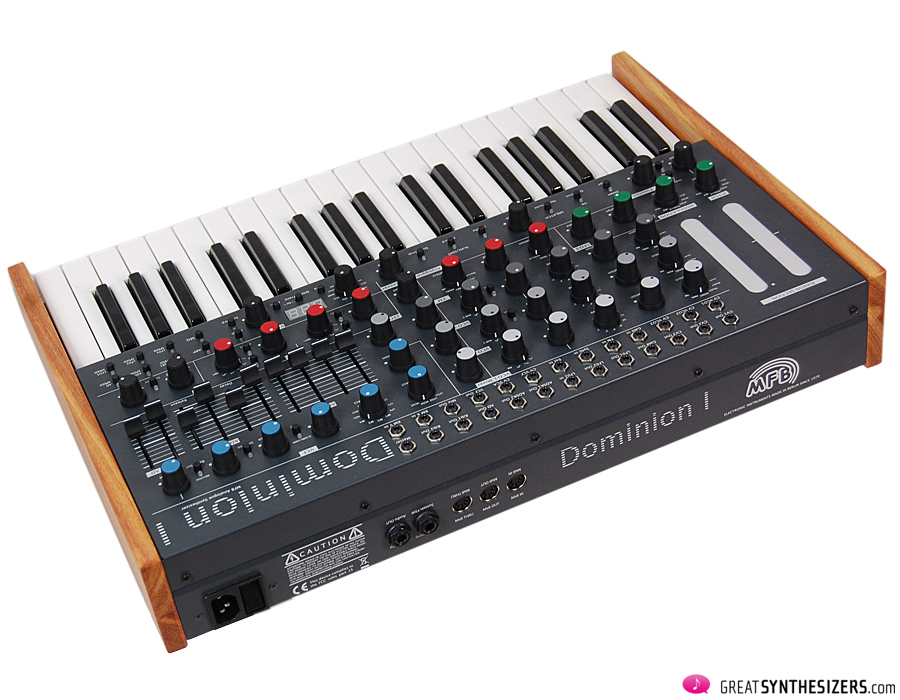

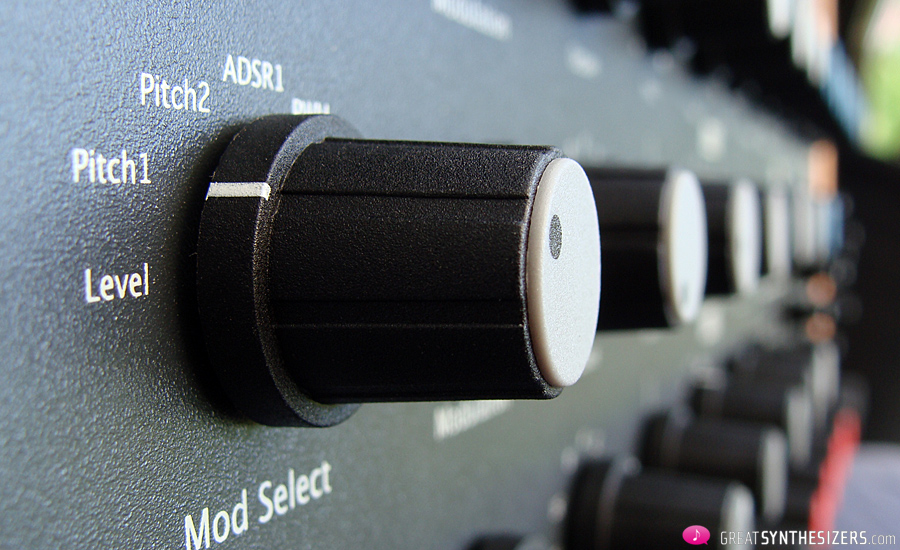
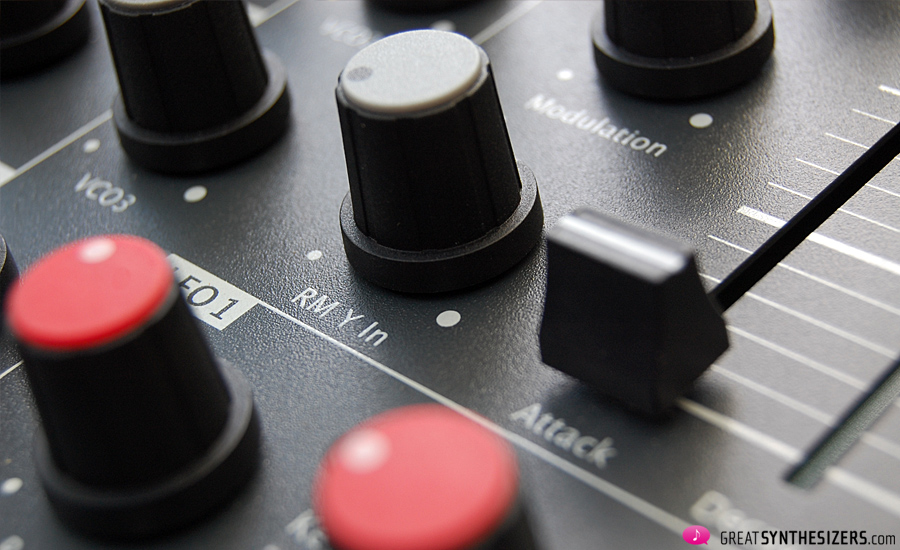
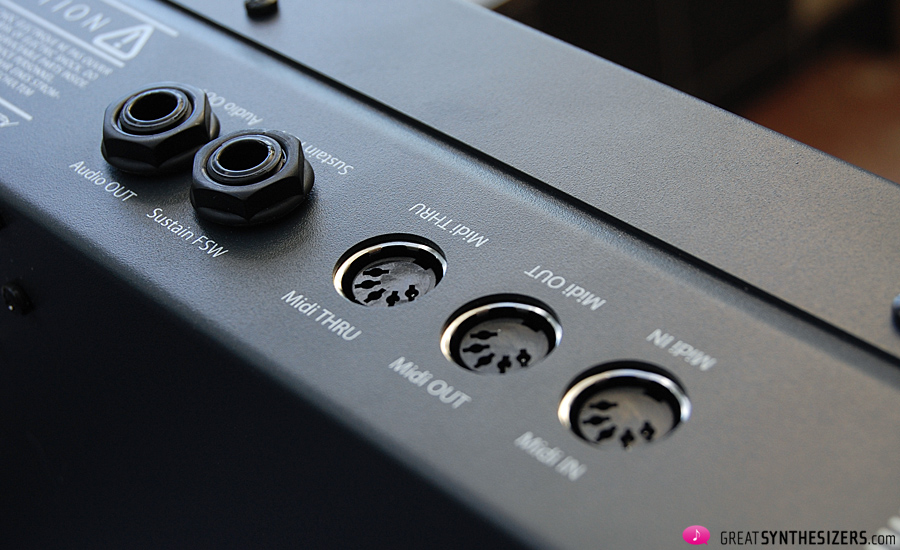
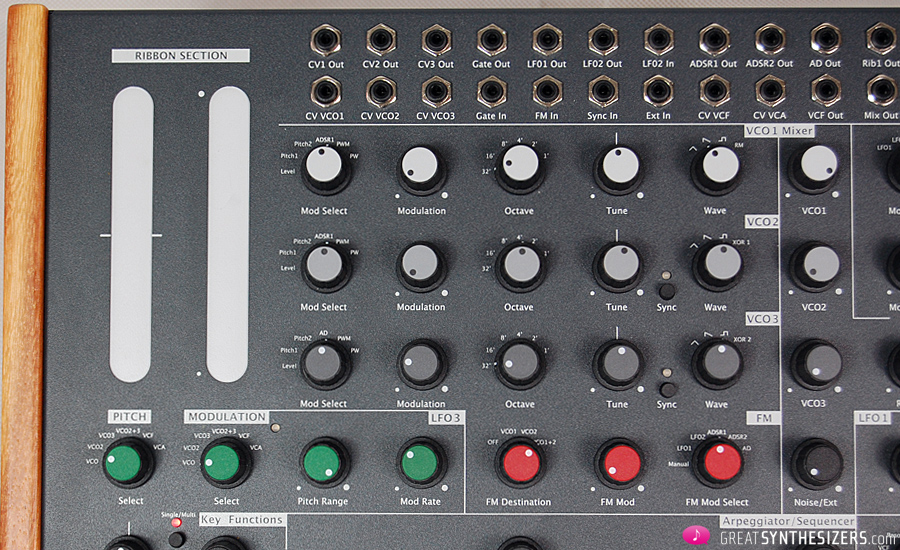

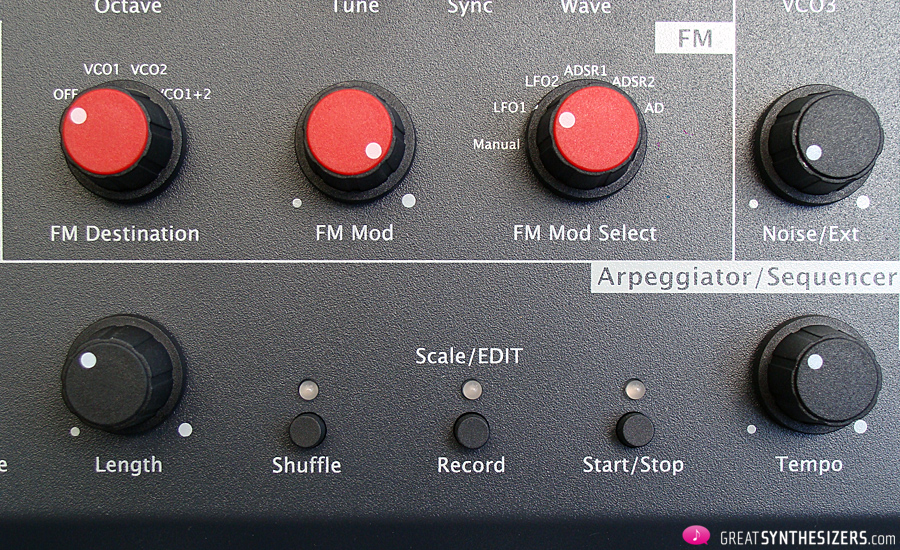



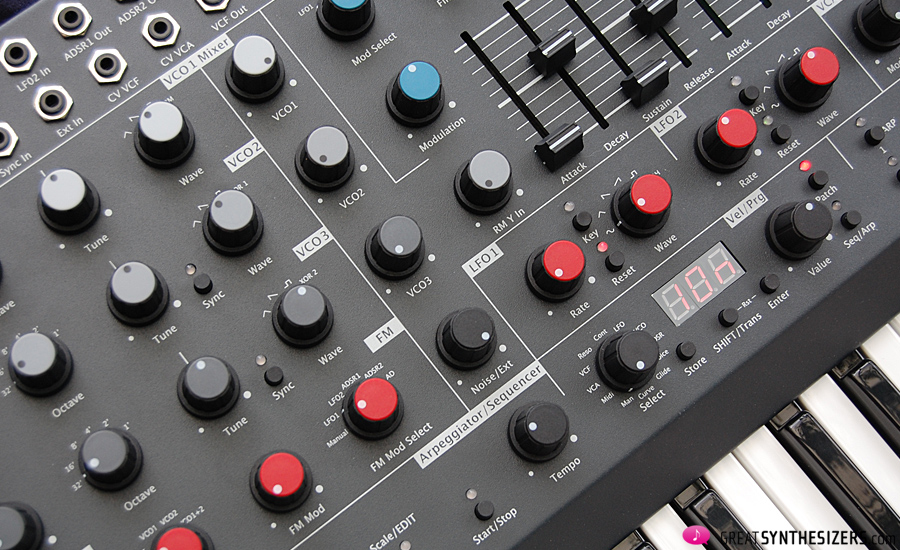
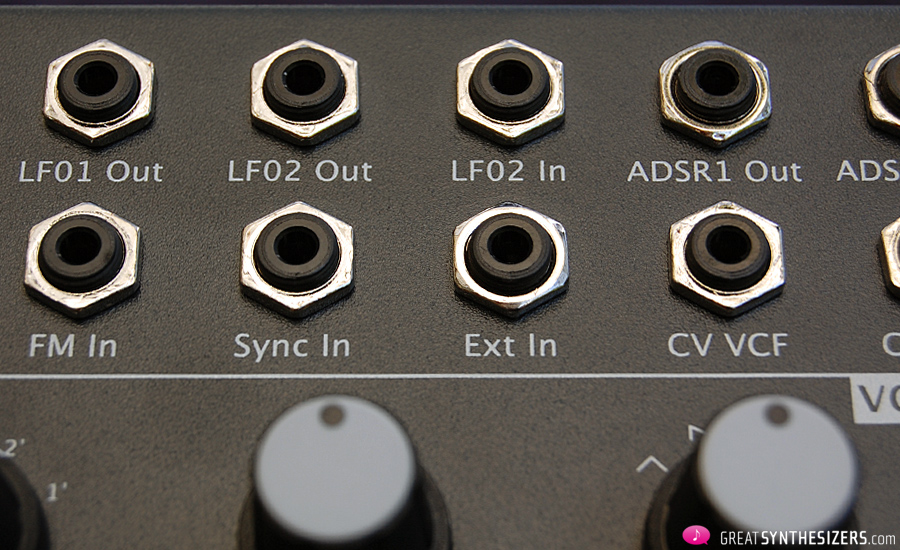

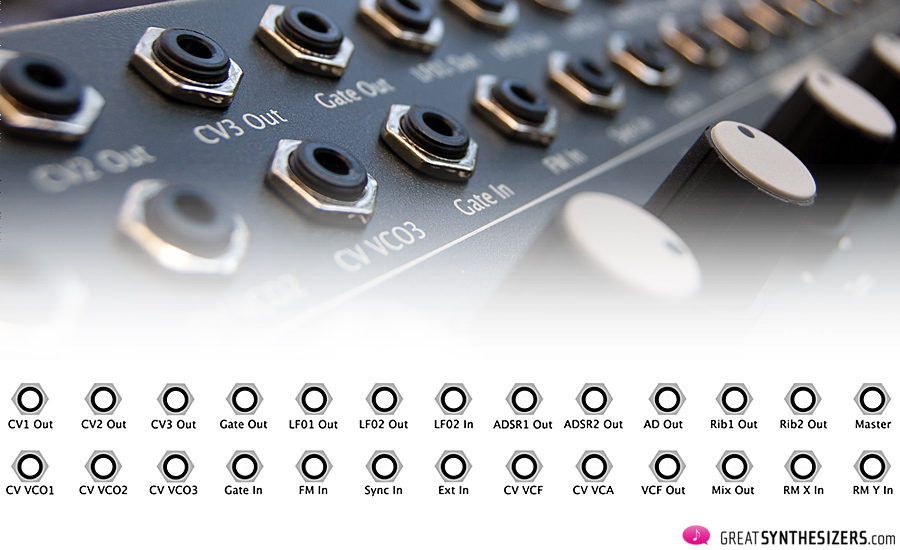
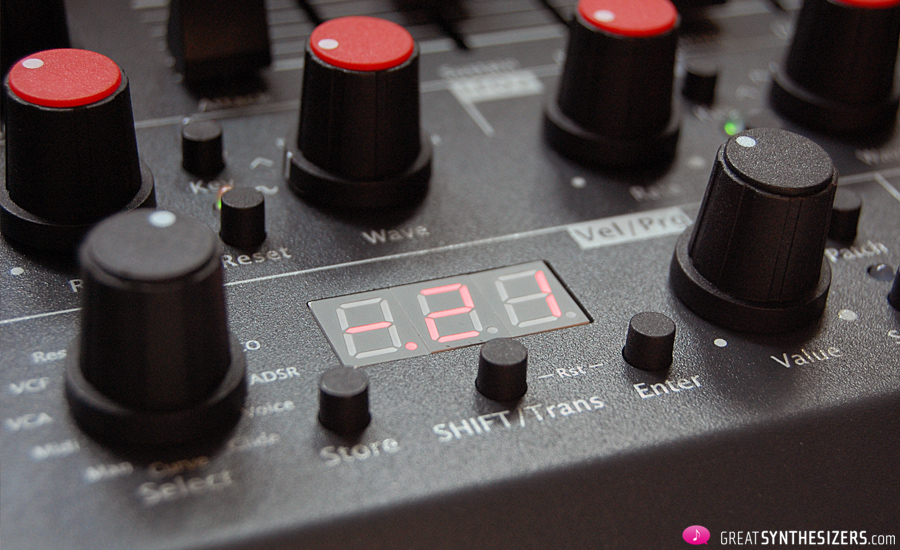
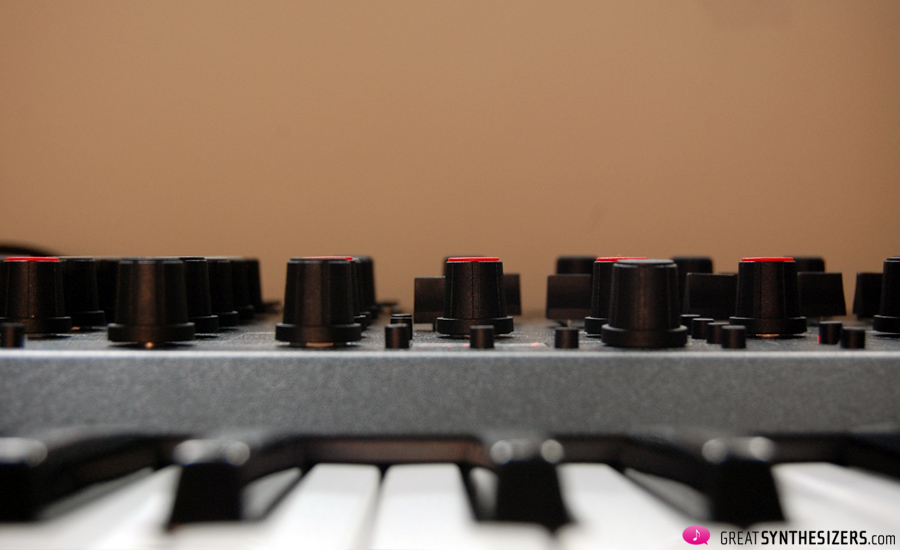

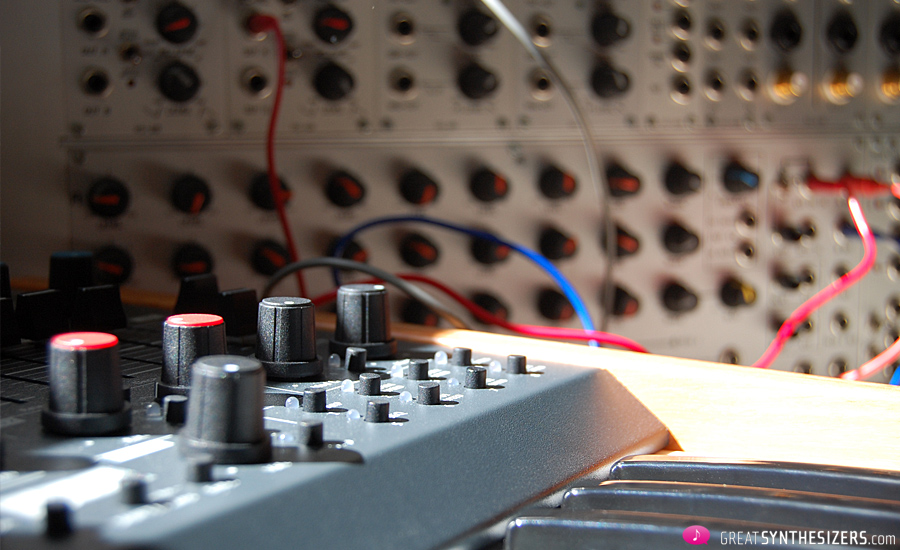
SEQUENCER: records notes, note lengths (dedicated knob), aftertouch (AT modulation knob), Glide values (Glide knob) and Ribbon 2 movements! When recording: knob positions (note length, AT mod, Glide) can be changed each time “before” you hit a new key – values are then recorded, along with the note information.
MIDI: notes, VEL, AT, Pitchbend, ModWheel, Prog Change, MIDI Clock … I hope that’s all correct … (have to study the instrument’s features again …).
Hi Theo, great review and examples.
Speaking of “Soft Solo”, would you mind sharing a little bit of the patch construction? I really like it, and a beginner in sound synthesis…
Best, Stéphane